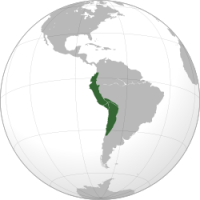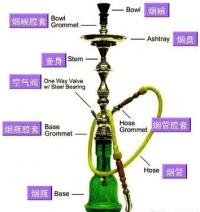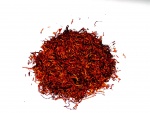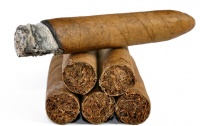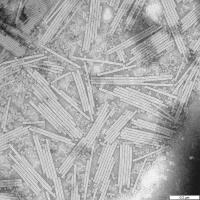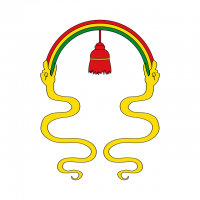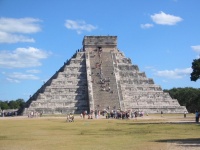北美俄亥俄州出土水獺外形個煙斗:修訂版本之間的差異
出自六年制學程
(→菸斗、菸種類) |
|||
| (未顯示2位用戶所作出之39次版本) | |||
| 第 1 行: | 第 1 行: | ||
| − | === | + | [[分類:大英博物館百品特展]] |
| + | ===展品基本資料=== | ||
| + | [[File:British Museum otter pipe.jpg|313px|right]] | ||
*年代:西元前200年到西元100年之間 | *年代:西元前200年到西元100年之間 | ||
*出處:美國的俄亥俄州土塚市 | *出處:美國的俄亥俄州土塚市 | ||
| − | *高5. | + | *高5.1cm、深10cm、寬3.3cm |
*經緯度:40.3664、-82.7901 | *經緯度:40.3664、-82.7901 | ||
| − | |||
===簡介=== | ===簡介=== | ||
抽菸會帶來快樂與危險。這支菸斗在2000年前的北美洲非常流行。他的形狀就像一支卡祖笛,他有一把長柄和一個碗狀的東西,是用略帶紅色的石頭雕刻而成,下面有個長約10cm的平直底座,底座一邊挖了一個小孔,當作菸頭咬嘴,煙斗的碗狀物用來放菸草,石頭磨得很光滑,水賴的頭向著菸頭咬嘴,因此抽菸的人在抽菸時眼睛會正好凝視著水賴的眼睛,且鼻子和水賴的鼻子也會碰在一起。這便是世界上人類最早使用的煙斗,人類抽菸斗的歷史從此開始。 | 抽菸會帶來快樂與危險。這支菸斗在2000年前的北美洲非常流行。他的形狀就像一支卡祖笛,他有一把長柄和一個碗狀的東西,是用略帶紅色的石頭雕刻而成,下面有個長約10cm的平直底座,底座一邊挖了一個小孔,當作菸頭咬嘴,煙斗的碗狀物用來放菸草,石頭磨得很光滑,水賴的頭向著菸頭咬嘴,因此抽菸的人在抽菸時眼睛會正好凝視著水賴的眼睛,且鼻子和水賴的鼻子也會碰在一起。這便是世界上人類最早使用的煙斗,人類抽菸斗的歷史從此開始。 | ||
| + | |||
<img src="http://www.britishmuseum.org/images/mm040819_m.jpg" width="250" height="250" /> | <img src="http://www.britishmuseum.org/images/mm040819_m.jpg" width="250" height="250" /> | ||
| + | |||
===北美印第安文化=== | ===北美印第安文化=== | ||
| − | [[File: | + | [[File:印加帝國2.png|400px]] |
| + | [[File:印加帝國3.png|200px]] | ||
| − | + | *抽菸是北美洲宗教和禮儀上必備的一部份,北美東部部落會進行大量的菸草袋作為貿易項目,部落的人民往往會用菸斗抽菸。菸草作為醫藥用途,作為一種止痛劑。它被用於耳痛和牙痛,偶爾作為膏藥。 | |
| − | + | *詹姆斯城(Jamestown),約翰·羅爾夫(John Rolfe)是第一個知道如何種植菸草的人。1612年他引進素質優良的菸草種子,種出來的菸草品質更好。他在維吉尼亞州種植,並在英國出售,風味更受歡迎。羅爾夫和包爾坦酋長的女兒普卡康蒂公主(Pocahontas)結為夫妻。普卡康蒂的兒子也繼承父親的菸草種植業。 | |
| + | *佛教和尚戒飲酒,酒是五戒之一,但未提到戒菸。《四分戒》中第四卷甚至提到佛祖教人為了治療熱帶性疾病去吸菸的方法。中國佛協第六屆全國代表會議通過《全國漢傳佛教寺院共住規約通則》,明確禁止吸菸。 | ||
| + | 香菸約於明朝末年傳入中國。1637年,崇禎為了禁菸,勒令以斬首示眾懲罰私種私售者。不過遼東與後金苦戰的兵部尚書洪承疇卻上奏說「遼東士卒,嗜此若命」,導致禁菸過程出現障礙。《清史稿》列傳十八有遼西將領孫得功駐守義州時曾疏言:「禁淡巴菰(ㄍㄨ),令未能行。步兵皆用火器,尤宜申諭戒革……」。清初士人王士禛的筆記記載:「今世公卿士大夫下逮與隸婦女,無不嗜(ㄕˋ)菸草,田家種之連畛(ㄓㄣˇ),頗獲厚利。考之《本草》、《爾雅》,皆不載。」 | ||
| + | 目前只有略高於5%的世界人口受到反吸菸法的保護。世界衛生組織估計,與吸菸相關的疾病每年導致大約500萬人過早死亡,其中有大約60萬非吸菸者死於二手菸的危害。 | ||
===菸斗、菸種類=== | ===菸斗、菸種類=== | ||
| − | [[File: | + | [[File:水煙.JPG|200px]] |
| − | [[File: | + | [[File:煙絲.JPG|150px]] |
| − | [[File: | + | [[File:雪茄.JPG|200px]] |
| − | [[File: | + | [[File:香菸.jpeg|200px]] |
| − | + | ||
===菸草病毒=== | ===菸草病毒=== | ||
| − | [[File: | + | [[File:菸草鑲嵌病毒.jpg|200px]] |
| − | + | ||
| − | + | ||
*菸草鑲嵌病毒,又名菸草花葉病毒,是一種[https://zh.wikipedia.org/wiki/%E6%A0%B8%E7%B3%96%E6%A0%B8%E9%85%B8%E7%97%85%E6%AF%92 RNA病毒],專門感染植物,尤其是菸草及其他茄科植物,能使這些受感染的葉片看來斑駁污損,因此得名。 | *菸草鑲嵌病毒,又名菸草花葉病毒,是一種[https://zh.wikipedia.org/wiki/%E6%A0%B8%E7%B3%96%E6%A0%B8%E9%85%B8%E7%97%85%E6%AF%92 RNA病毒],專門感染植物,尤其是菸草及其他茄科植物,能使這些受感染的葉片看來斑駁污損,因此得名。 | ||
| + | |||
| + | ===國家、帝國=== | ||
| + | *印加帝國:11世紀至16世紀時位於南美洲的古老帝國,亦是前哥倫布時期美洲最大的帝國 | ||
| + | [[File:印加帝國國徽.png|200px]] | ||
| + | *阿茲特克:是一個存在於14世紀至16世紀的墨西哥古文明,是前哥倫布時期中美洲最大的帝國,也形成了獨特的阿茲特克文明。 | ||
| + | [[File:阿茲特克金字塔.jpg|200px]] | ||
===參考連結=== | ===參考連結=== | ||
| 第 42 行: | 第 52 行: | ||
*[https://translate.google.com.tw/#en/zh-TW/Indigenous%20peoples%20of%20the%20Great%20Basin%0A%E5%87%BA%E8%87%AA%20Wikipedia%0A(%E5%B7%B2%E9%87%8D%E6%96%B0%E5%B0%8E%E5%90%91%E8%87%AA%20Desert%20Culture)%0A%0AThe%20Great%20Basin%20tribes%20region%20at%20the%20time%20of%20European%20contact%20was%20~400%2C000%20sq%20mi%20(1%2C000%2C000%20km2).%5B1%5D%3A220%0AThe%20Indigenous%20peoples%20of%20the%20Great%20Basin%20are%20Native%20Americans%20of%20the%20northern%20Great%20Basin%2C%20Snake%20River%20Plain%20and%20upper%20Colorado%20River%20basin.%20The%20%22Great%20Basin%22%20is%20a%20cultural%20classification%20of%20indigenous%20peoples%20of%20the%20Americas%20and%20a%20cultural%20region%20located%20between%20the%20Rocky%20Mountains%20and%20the%20Sierra%20Nevada%2C%20in%20what%20is%20now%20Nevada%2C%20and%20parts%20of%20Oregon%2C%20California%2C%20Idaho%2C%20Wyoming%2C%20and%20Utah.%20There%20is%20very%20little%20precipitation%20in%20the%20Great%20Basin%20area%20which%20affects%20the%20lifestyles%20and%20cultures%20of%20the%20inhabitants.%0A%E7%9B%AE%E9%8C%84%20%20%5B%E9%9A%B1%E8%97%8F%5D%20%0A1%20History%0A2%20Cultures%0A3%20Great%20Basin%20peoples%0A3.1%20Paiute%0A3.2%20Shoshone%0A3.3%20Ute%0A4%20Notes%0AHistory%5B%E7%B7%A8%E8%BC%AF%5D%0A%0AFremont%20culture%20petroglyphs%20of%20big%20horn%20sheep%2C%20Nine%20Mile%20Canyon%2C%20Utah%0A%0ARuby%20Snyder%20(Chemehuevi)%2C%20from%20Parker%2C%20Arizona%2C%201942%0AOriginal%20inhabitants%20of%20the%20region%20may%20have%20arrived%20by%2012%2C000%20BCE.%209%2C000%20BCE%20to%20400%20CE%20marks%20the%20Great%20Basin%20Desert%20Archaic%20Period%2C%20following%20by%20the%20time%20of%20the%20Fremont%20culture%2C%20who%20were%20hunter-gatherers%2C%20as%20well%20as%20agriculturalists.%20Numic%20language-speakers%2C%20ancestors%20of%20today's%20Western%20Shoshone%20and%20both%20Northern%20and%20Southern%20Paiute%20peoples%20entered%20the%20region%20around%20the%2014th%20century%20CE.%5B2%5D%0AThe%20first%20Europeans%20to%20reach%20the%20area%20were%20the%20Spanish%20Dominguez-Escalante%20Expedition%2C%20who%20passed%20far%20from%20present%20day%20Delta%2C%20Utah%20in%201776.%5B2%5D%20Great%20Basin%20settlement%20was%20relatively%20free%20of%20non-Native%20settlers%20until%20the%20first%20Mormon%20settlers%20arrived%20in%201847.%20Within%20ten%20years%2C%20the%20first%20Indian%20reservation%20was%20established%2C%20in%20order%20to%20assimilate%20the%20native%20population.%20The%20Goshute%20Reservation%20was%20created%20in%201863.%5B2%5D%20The%20attempted%20acculturation%20process%20included%20sending%20children%20to%20Indian%20schools%20and%20limiting%20the%20landbases%20and%20resources%20of%20the%20reservations.%0ABecause%20their%20contact%20with%20European-Americans%20and%20African-Americans%20occurred%20comparatively%20late%2C%20Great%20Basin%20tribes%20maintain%20their%20religion%20and%20culture%20and%20were%20leading%20proponents%20of%2019th%20century%20cultural%20and%20religious%20renewals.%20Two%20Paiute%20prophets%2C%20Wodziwob%20and%20Wovoka%2C%20introduced%20the%20Ghost%20Dance%20in%20a%20ceremony%20to%20commune%20with%20departed%20loved%20ones%20and%20bring%20renewal%20of%20buffalo%20herds%20and%20precontact%20lifeways.%20The%20Ute%20Bear%20Dance%20emerged%20on%20the%20Great%20Basin.%20The%20Sun%20Dance%20and%20Peyote%20religion%20flourished%20in%20the%20Great%20Basin%2C%20as%20well.%5B3%5D%0AIn%201930%2C%20the%20Ely%20Shoshone%20Reservation%20was%20established%2C%20followed%20by%20the%20Duckwater%20Indian%20Reservation%20in%201940.%5B2%5D%0AConditions%20for%20the%20Native%20American%20population%20of%20the%20Great%20Basin%20were%20erratic%20throughout%20the%2020th%20century.%20Economic%20improvement%20emerged%20as%20a%20result%20of%20President%20Franklin%20Roosevelt's%20Indian%20New%20Deal%20in%20the%201930s%2C%20while%20activism%20and%20legal%20victories%20in%20the%201970s%20have%20improved%20conditions%20significantly.%20Nevertheless%2C%20the%20communities%20continue%20to%20struggle%20against%20chronic%20poverty%20and%20all%20of%20the%20resulting%20problems%3A%20unemployment%3B%20substance%20abuse%3B%20and%20high%20suicide%20rates.%0AToday%20self-determination%2C%20beginning%20with%20the%201975%20passage%20of%20the%20Indian%20Self-determination%20and%20Education%20Assistance%20Act%2C%5B2%5D%20has%20enabled%20Great%20Basin%20tribes%20to%20develop%20economic%20opportunities%20for%20their%20members.%0ACultures%5B%E7%B7%A8%E8%BC%AF%5D%0A%0ABeaded%20moccasins%20that%20belonged%20to%20Chief%20Washakie%20(Shoshone)%2C%20Wyoming%2C%20c.%201900%0ADifferent%20ethnic%20groups%20of%20Great%20Basin%20tribes%20share%20certain%20common%20cultural%20elements%20that%20distinguish%20them%20from%20surrounding%20groups.%20All%20but%20the%20Washoe%20traditional%20speak%20Numic%20languages%2C%20and%20there%20has%20been%20considerable%20intermingling%20between%20the%20groups%2C%20who%20historically%20lived%20peacefully%20and%20often%20shared%20common%20territories.%20Prior%20to%20the%2020th%20century%2C%20Great%20Basin%20peoples%20were%20predominantly%20hunters%20and%20gatherers.%0A%22Desert%20Archaic%22%20or%20more%20simply%20%22The%20Desert%20Culture%22%20refers%20to%20the%20culture%20of%20the%20Great%20Basin%20tribes.%20This%20culture%20is%20characterized%20by%20the%20need%20for%20mobility%20to%20take%20advantage%20of%20seasonally%20available%20food%20supplies.%20The%20use%20of%20pottery%20was%20rare%20due%20to%20its%20weight%2C%20but%20intricate%20baskets%20were%20woven%20for%20containing%20water%2C%20cooking%20food%2C%20winnowing%20grass%20seeds%20and%20storage%E2%80%94including%20the%20storage%20of%20pine%20nuts%2C%20a%20Paiute-Shoshone%20staple.%20Heavy%20items%20such%20as%20metates%20would%20be%20cached%20rather%20than%20carried%20from%20foraging%20area%20to%20foraging%20area.%20Agriculture%20was%20not%20practiced%20within%20the%20Great%20Basin%20itself%2C%20although%20it%20was%20practiced%20in%20adjacent%20areas%20(modern%20agriculture%20in%20the%20Great%20Basin%20requires%20either%20large%20mountain%20reservoirs%20or%20deep%20artesian%20wells).%20Likewise%2C%20the%20Great%20Basin%20tribes%20had%20no%20permanent%20settlements%2C%20although%20winter%20villages%20might%20be%20revisited%20winter%20after%20winter%20by%20the%20same%20group%20of%20families.%20In%20the%20summer%2C%20the%20largest%20group%20was%20usually%20the%20nuclear%20family%20due%20to%20the%20low%20density%20of%20food%20supplies.%0AIn%20the%20early%20historical%20period%20the%20Great%20Basin%20tribes%20were%20actively%20expanding%20to%20the%20north%20and%20east%2C%20where%20they%20developed%20a%20horse-riding%20bison-hunting%20culture.%20These%20people%2C%20including%20the%20Bannock%20and%20Eastern%20Shoshone%20share%20traits%20with%20Plains%20Indians.%0AGreat%20Basin%20peoples%5B%E7%B7%A8%E8%BC%AF%5D%0ABannock%2C%20Idaho%5B4%5D%0ACoso%20People%2C%20of%20Coso%20Rock%20Art%20District%20in%20the%20Coso%20Range%2C%20Mojave%20Desert%20California%0AFremont%20culture%20(400%20CE%E2%80%931300%20CE)%2C%20Utah%5B3%5D%3A161%0AKawaiisu%2C%20southern%20inland%20California%5B4%5D%0AMono%2C%20southeastern%20California%0AEastern%20Mono%20(Owens%20Valley%20Paiute)%2C%20southeastern%20California%0AWestern%20Mono%2C%20southeastern%20California%0ATimbisha%20or%20Panamint%20or%20Koso%2C%20southeastern%20California%0AWasho%2C%20Nevada%20and%20California%5B5%5D%0APalagewan%0APahkanapil%0APaiute%5B%E7%B7%A8%E8%BC%AF%5D%0AMain%20article%3A%20Paiute%20people%0ANorthern%20Paiute%2C%20eastern%20California%2C%20Nevada%2C%20Oregon%2C%20southwestern%20Idaho%5B4%5D%0AKucadikadi%2C%20Mono%20Lake%20Paiute%2C%20California%0AOwens%20Valley%20Paiute%2C%20California%20Nevada%0ASouthern%20Paiute%2C%20Arizona%2C%20Nevada%2C%20Utah%5B6%5D%0AChemehuevi%2C%20southeastern%20California%0AKaibab%2C%20northwestern%20Arizona%0AKaiparowtis%2C%20southwestern%20Utah%0AMoapa%2C%20southern%20Nevada%0APanaca%0APanguitch%2C%20Utah%0AParanigets%2C%20southern%20Nevada%0AShivwits%2C%20southwestern%20Utah%0AShoshone%5B%E7%B7%A8%E8%BC%AF%5D%0A%0ATindoor%2C%20Lemhi%20Shoshone%20chief%20and%20his%20wife%2C%20ca.%201897%2C%20photograph%20by%20Benedicte%20Wrensted%0AMain%20article%3A%20Shoshone%0AEastern%20Shoshone%20people%3A%0AGuchundeka'%2C%20Kuccuntikka%2C%20Buffalo%20Eaters%5B7%5D%5B8%5D%0ATukkutikka%2C%20Tukudeka%2C%20Mountain%20Sheep%20Eaters%2C%20joined%20the%20Northern%20Shoshone%5B8%5D%0ABoho'inee'%2C%20Pohoini%2C%20Pohogwe%2C%20Sage%20Grass%20people%2C%20Sagebrush%20Butte%20People%5B7%5D%5B8%5D%5B9%5D%0ANorthern%20Shoshone%20people%3A%0AAgaideka%2C%20Salmon%20Eaters%2C%20Lemhi%2C%20Snake%20River%20and%20Lemhi%20River%20Valley%5B9%5D%5B10%5D%5B9%5D%0ADoyahinee'%2C%20Mountain%20people%5B7%5D%0AKammedeka%2C%20Kammitikka%2C%20Jack%20Rabbit%20Eaters%2C%20Snake%20River%2C%20Great%20Salt%20Lake%5B9%5D%0AHukund%C3%BCka%2C%20Porcupine%20Grass%20Seed%20Eaters%2C%20Wild%20Wheat%20Eaters%2C%20possibly%20synonymous%20with%20Kammitikka%5B9%5D%5B11%5D%0ATukudeka%2C%20Dukundeka'%2C%20Sheep%20Eaters%20(Mountain%20Sheep%20Eaters)%2C%20Sawtooth%20Range%2C%20Idaho%5B10%5D%5B9%5D%0AYahandeka%2C%20Yakandika%2C%20Groundhog%20Eaters%2C%20lower%20Boise%2C%20Payette%2C%20and%20Wiser%20Rivers%5B10%5D%5B9%5D%0AWestern%20Shoshone%20people%3A%0AKusiutta%2C%20Goshute%20(Gosiute)%2C%20Great%20Salt%20Desrt%20and%20Great%20Salt%20Lake%2C%20Utah%5B11%5D%0ACedar%20Valley%20Goshute%0ADeep%20Creek%20Goshute%0ARush%20Valley%20Goshute%0ASkull%20Valley%20Goshute%2C%20Wipayutta%2C%20Weber%20Ute%5B11%5D%0AToole%20Valley%20Goshute%0ATrout%20Creek%20Goshute%5B11%5D%0AKuyatikka%2C%20Kuyudikka%2C%20Bitterroot%20Eaters%2C%20Halleck%2C%20Mary's%20River%2C%20Clover%20Valley%2C%20Smith%20Creek%20Valley%2C%20Nevada%5B11%5D%0AMahaguad%C3%BCka%2C%20Mentzelia%20Seed%20Eaters%2C%20Ruby%20Valley%2C%20Nevada%5B11%5D%0APainkwitikka%2C%20Penkwitikka%2C%20Fish%20Eaters%2C%20Cache%20Valley%2C%20Idaho%20and%20Utah%5B11%5D%0APasiatikka%2C%20Redtop%20Grass%20Eaters%2C%20Deep%20Creek%20Gosiute%2C%20Deep%20Creek%20Valley%2C%20Antelope%20Valley%5B11%5D%0ATipatikka%2C%20Pinenut%20Eaters%2C%20northernmost%20band%5B11%5D%0ATsaiduka%2C%20Tule%20Eaters%2C%20Railroad%20Valley%2C%20Nevada%5B11%5D%0ATsogwiyuyugi%2C%20Elko%2C%20Nevada%5B11%5D%0AWaitikka%2C%20Ricegrass%20Eaters%2C%20Ione%20Valley%2C%20Nevada%5B11%5D%0AWatatikka%2C%20Ryegrass%20Seed%20Eaters%2C%20Ruby%20Valley%2C%20Nevada%5B11%5D%0AWiyimpihtikka%2C%20Buffalo%20Berry%20Eaters%5B11%5D%0AUte%5B%E7%B7%A8%E8%BC%AF%5D%0AMain%20article%3A%20Ute%20people%0ACapote%2C%20southeastern%20Colorado%20and%20New%20Mexico%5B3%5D%3A339%0AMoanunts%2C%20Salina%2C%20Utah%0AMuache%2C%20south%20and%20central%20Colorado%5B3%5D%3A282%0APahvant%2C%20western%20Utah%0ASanpits%2C%20central%20Utah%0ATimpanogots%2C%20north%20central%20Utah%0AUintah%2C%20Utah%0AUncompahgre%20or%20Taviwach%2C%20central%20and%20northern%20Colorado%0AWeeminuche%2C%20western%20Colorado%2C%20eastern%20Utah%2C%20northwestern%20New%20Mexico%0AWhite%20River%20Utes%20(Parusanuch%20and%20Yampa)%2C%20Colorado%20and%20eastern%20Utah%0ANotes%5B%E7%B7%A8%E8%BC%AF%5D%0A%E7%A7%BB%E8%87%B3%20%5E%20Pritzker%2C%20Barry%20M%20(2000).%20A%20Native%20American%20Encyclopedia%3A%20History%2C%20Culture%2C%20and%20Peoples%20(Google%20Books).%20Oxford%3A%20Oxford%20University%20Press.%20p.%20220.%20ISBN%20978-0-19-513877-1.%20Retrieved%202010-06-04.%0A%5E%20%E7%A7%BB%E8%87%B3%EF%BC%9A%20a%20b%20c%20d%20e%20%22History%20Timeline%20of%20Great%20Basin%20National%20Heritage%20Area.%22%20Great%20Basin%20National%20Heritage%20Area.%20Retrieved%2024%20June%202013.%0A%5E%20%E7%A7%BB%E8%87%B3%EF%BC%9A%20a%20b%20c%20d%20D'Azevedo%2C%20Warren%20L%20(editor)%20(1986).%20Volume%2011%3A%20Great%20Basin.%20Handbook%20of%20North%20American%20Indians%20(Washington%2C%20DC%3A%20Smithsonian%20Institution).%20ISBN%20978-0-16-004581-3.%0A%5E%20%E7%A7%BB%E8%87%B3%EF%BC%9A%20a%20b%20c%20D'Azevedo%20ix%0A%E7%A7%BB%E8%87%B3%20%5E%20Nicholas%2C%20Walter%20S.%20%22A%20Short%20History%20of%20Johnsondale%22.%20RRanch.org.%20Retrieved%202010-06-04.%0A%E7%A7%BB%E8%87%B3%20%5E%20Pritzker%20230%0A%5E%20%E7%A7%BB%E8%87%B3%EF%BC%9A%20a%20b%20c%20Loether%2C%20Christopher.%20%22Shoshones.%22%20Encyclopedia%20of%20the%20Great%20Plains.%20Retrieved%2020%20Oct%202013.%0A%5E%20%E7%A7%BB%E8%87%B3%EF%BC%9A%20a%20b%20c%20Shimkin%20335%0A%5E%20%E7%A7%BB%E8%87%B3%EF%BC%9A%20a%20b%20c%20d%20e%20f%20g%20Murphy%20and%20Murphy%20306%0A%5E%20%E7%A7%BB%E8%87%B3%EF%BC%9A%20a%20b%20c%20Murphy%20and%20Murphy%20287%0A%5E%20%E7%A7%BB%E8%87%B3%EF%BC%9A%20a%20b%20c%20d%20e%20f%20g%20h%20i%20j%20k%20l%20m%20n%20Thomas%2C%20Pendleton%2C%20and%20Cappannari%20280%E2%80%93283%0AThe%20Great%20Basin%20tribes%20region%20at%20the%20time%20of%20European%20contact%20was%20~400%2C000%20sq%20mi%20(1%2C000%2C000%20km2).%5B1%5D%3A220%0ATMV%20Virus%20Super%20Resolution%20Mikroskopie 大盆地的原住民(出自維基百科)] | *[https://translate.google.com.tw/#en/zh-TW/Indigenous%20peoples%20of%20the%20Great%20Basin%0A%E5%87%BA%E8%87%AA%20Wikipedia%0A(%E5%B7%B2%E9%87%8D%E6%96%B0%E5%B0%8E%E5%90%91%E8%87%AA%20Desert%20Culture)%0A%0AThe%20Great%20Basin%20tribes%20region%20at%20the%20time%20of%20European%20contact%20was%20~400%2C000%20sq%20mi%20(1%2C000%2C000%20km2).%5B1%5D%3A220%0AThe%20Indigenous%20peoples%20of%20the%20Great%20Basin%20are%20Native%20Americans%20of%20the%20northern%20Great%20Basin%2C%20Snake%20River%20Plain%20and%20upper%20Colorado%20River%20basin.%20The%20%22Great%20Basin%22%20is%20a%20cultural%20classification%20of%20indigenous%20peoples%20of%20the%20Americas%20and%20a%20cultural%20region%20located%20between%20the%20Rocky%20Mountains%20and%20the%20Sierra%20Nevada%2C%20in%20what%20is%20now%20Nevada%2C%20and%20parts%20of%20Oregon%2C%20California%2C%20Idaho%2C%20Wyoming%2C%20and%20Utah.%20There%20is%20very%20little%20precipitation%20in%20the%20Great%20Basin%20area%20which%20affects%20the%20lifestyles%20and%20cultures%20of%20the%20inhabitants.%0A%E7%9B%AE%E9%8C%84%20%20%5B%E9%9A%B1%E8%97%8F%5D%20%0A1%20History%0A2%20Cultures%0A3%20Great%20Basin%20peoples%0A3.1%20Paiute%0A3.2%20Shoshone%0A3.3%20Ute%0A4%20Notes%0AHistory%5B%E7%B7%A8%E8%BC%AF%5D%0A%0AFremont%20culture%20petroglyphs%20of%20big%20horn%20sheep%2C%20Nine%20Mile%20Canyon%2C%20Utah%0A%0ARuby%20Snyder%20(Chemehuevi)%2C%20from%20Parker%2C%20Arizona%2C%201942%0AOriginal%20inhabitants%20of%20the%20region%20may%20have%20arrived%20by%2012%2C000%20BCE.%209%2C000%20BCE%20to%20400%20CE%20marks%20the%20Great%20Basin%20Desert%20Archaic%20Period%2C%20following%20by%20the%20time%20of%20the%20Fremont%20culture%2C%20who%20were%20hunter-gatherers%2C%20as%20well%20as%20agriculturalists.%20Numic%20language-speakers%2C%20ancestors%20of%20today's%20Western%20Shoshone%20and%20both%20Northern%20and%20Southern%20Paiute%20peoples%20entered%20the%20region%20around%20the%2014th%20century%20CE.%5B2%5D%0AThe%20first%20Europeans%20to%20reach%20the%20area%20were%20the%20Spanish%20Dominguez-Escalante%20Expedition%2C%20who%20passed%20far%20from%20present%20day%20Delta%2C%20Utah%20in%201776.%5B2%5D%20Great%20Basin%20settlement%20was%20relatively%20free%20of%20non-Native%20settlers%20until%20the%20first%20Mormon%20settlers%20arrived%20in%201847.%20Within%20ten%20years%2C%20the%20first%20Indian%20reservation%20was%20established%2C%20in%20order%20to%20assimilate%20the%20native%20population.%20The%20Goshute%20Reservation%20was%20created%20in%201863.%5B2%5D%20The%20attempted%20acculturation%20process%20included%20sending%20children%20to%20Indian%20schools%20and%20limiting%20the%20landbases%20and%20resources%20of%20the%20reservations.%0ABecause%20their%20contact%20with%20European-Americans%20and%20African-Americans%20occurred%20comparatively%20late%2C%20Great%20Basin%20tribes%20maintain%20their%20religion%20and%20culture%20and%20were%20leading%20proponents%20of%2019th%20century%20cultural%20and%20religious%20renewals.%20Two%20Paiute%20prophets%2C%20Wodziwob%20and%20Wovoka%2C%20introduced%20the%20Ghost%20Dance%20in%20a%20ceremony%20to%20commune%20with%20departed%20loved%20ones%20and%20bring%20renewal%20of%20buffalo%20herds%20and%20precontact%20lifeways.%20The%20Ute%20Bear%20Dance%20emerged%20on%20the%20Great%20Basin.%20The%20Sun%20Dance%20and%20Peyote%20religion%20flourished%20in%20the%20Great%20Basin%2C%20as%20well.%5B3%5D%0AIn%201930%2C%20the%20Ely%20Shoshone%20Reservation%20was%20established%2C%20followed%20by%20the%20Duckwater%20Indian%20Reservation%20in%201940.%5B2%5D%0AConditions%20for%20the%20Native%20American%20population%20of%20the%20Great%20Basin%20were%20erratic%20throughout%20the%2020th%20century.%20Economic%20improvement%20emerged%20as%20a%20result%20of%20President%20Franklin%20Roosevelt's%20Indian%20New%20Deal%20in%20the%201930s%2C%20while%20activism%20and%20legal%20victories%20in%20the%201970s%20have%20improved%20conditions%20significantly.%20Nevertheless%2C%20the%20communities%20continue%20to%20struggle%20against%20chronic%20poverty%20and%20all%20of%20the%20resulting%20problems%3A%20unemployment%3B%20substance%20abuse%3B%20and%20high%20suicide%20rates.%0AToday%20self-determination%2C%20beginning%20with%20the%201975%20passage%20of%20the%20Indian%20Self-determination%20and%20Education%20Assistance%20Act%2C%5B2%5D%20has%20enabled%20Great%20Basin%20tribes%20to%20develop%20economic%20opportunities%20for%20their%20members.%0ACultures%5B%E7%B7%A8%E8%BC%AF%5D%0A%0ABeaded%20moccasins%20that%20belonged%20to%20Chief%20Washakie%20(Shoshone)%2C%20Wyoming%2C%20c.%201900%0ADifferent%20ethnic%20groups%20of%20Great%20Basin%20tribes%20share%20certain%20common%20cultural%20elements%20that%20distinguish%20them%20from%20surrounding%20groups.%20All%20but%20the%20Washoe%20traditional%20speak%20Numic%20languages%2C%20and%20there%20has%20been%20considerable%20intermingling%20between%20the%20groups%2C%20who%20historically%20lived%20peacefully%20and%20often%20shared%20common%20territories.%20Prior%20to%20the%2020th%20century%2C%20Great%20Basin%20peoples%20were%20predominantly%20hunters%20and%20gatherers.%0A%22Desert%20Archaic%22%20or%20more%20simply%20%22The%20Desert%20Culture%22%20refers%20to%20the%20culture%20of%20the%20Great%20Basin%20tribes.%20This%20culture%20is%20characterized%20by%20the%20need%20for%20mobility%20to%20take%20advantage%20of%20seasonally%20available%20food%20supplies.%20The%20use%20of%20pottery%20was%20rare%20due%20to%20its%20weight%2C%20but%20intricate%20baskets%20were%20woven%20for%20containing%20water%2C%20cooking%20food%2C%20winnowing%20grass%20seeds%20and%20storage%E2%80%94including%20the%20storage%20of%20pine%20nuts%2C%20a%20Paiute-Shoshone%20staple.%20Heavy%20items%20such%20as%20metates%20would%20be%20cached%20rather%20than%20carried%20from%20foraging%20area%20to%20foraging%20area.%20Agriculture%20was%20not%20practiced%20within%20the%20Great%20Basin%20itself%2C%20although%20it%20was%20practiced%20in%20adjacent%20areas%20(modern%20agriculture%20in%20the%20Great%20Basin%20requires%20either%20large%20mountain%20reservoirs%20or%20deep%20artesian%20wells).%20Likewise%2C%20the%20Great%20Basin%20tribes%20had%20no%20permanent%20settlements%2C%20although%20winter%20villages%20might%20be%20revisited%20winter%20after%20winter%20by%20the%20same%20group%20of%20families.%20In%20the%20summer%2C%20the%20largest%20group%20was%20usually%20the%20nuclear%20family%20due%20to%20the%20low%20density%20of%20food%20supplies.%0AIn%20the%20early%20historical%20period%20the%20Great%20Basin%20tribes%20were%20actively%20expanding%20to%20the%20north%20and%20east%2C%20where%20they%20developed%20a%20horse-riding%20bison-hunting%20culture.%20These%20people%2C%20including%20the%20Bannock%20and%20Eastern%20Shoshone%20share%20traits%20with%20Plains%20Indians.%0AGreat%20Basin%20peoples%5B%E7%B7%A8%E8%BC%AF%5D%0ABannock%2C%20Idaho%5B4%5D%0ACoso%20People%2C%20of%20Coso%20Rock%20Art%20District%20in%20the%20Coso%20Range%2C%20Mojave%20Desert%20California%0AFremont%20culture%20(400%20CE%E2%80%931300%20CE)%2C%20Utah%5B3%5D%3A161%0AKawaiisu%2C%20southern%20inland%20California%5B4%5D%0AMono%2C%20southeastern%20California%0AEastern%20Mono%20(Owens%20Valley%20Paiute)%2C%20southeastern%20California%0AWestern%20Mono%2C%20southeastern%20California%0ATimbisha%20or%20Panamint%20or%20Koso%2C%20southeastern%20California%0AWasho%2C%20Nevada%20and%20California%5B5%5D%0APalagewan%0APahkanapil%0APaiute%5B%E7%B7%A8%E8%BC%AF%5D%0AMain%20article%3A%20Paiute%20people%0ANorthern%20Paiute%2C%20eastern%20California%2C%20Nevada%2C%20Oregon%2C%20southwestern%20Idaho%5B4%5D%0AKucadikadi%2C%20Mono%20Lake%20Paiute%2C%20California%0AOwens%20Valley%20Paiute%2C%20California%20Nevada%0ASouthern%20Paiute%2C%20Arizona%2C%20Nevada%2C%20Utah%5B6%5D%0AChemehuevi%2C%20southeastern%20California%0AKaibab%2C%20northwestern%20Arizona%0AKaiparowtis%2C%20southwestern%20Utah%0AMoapa%2C%20southern%20Nevada%0APanaca%0APanguitch%2C%20Utah%0AParanigets%2C%20southern%20Nevada%0AShivwits%2C%20southwestern%20Utah%0AShoshone%5B%E7%B7%A8%E8%BC%AF%5D%0A%0ATindoor%2C%20Lemhi%20Shoshone%20chief%20and%20his%20wife%2C%20ca.%201897%2C%20photograph%20by%20Benedicte%20Wrensted%0AMain%20article%3A%20Shoshone%0AEastern%20Shoshone%20people%3A%0AGuchundeka'%2C%20Kuccuntikka%2C%20Buffalo%20Eaters%5B7%5D%5B8%5D%0ATukkutikka%2C%20Tukudeka%2C%20Mountain%20Sheep%20Eaters%2C%20joined%20the%20Northern%20Shoshone%5B8%5D%0ABoho'inee'%2C%20Pohoini%2C%20Pohogwe%2C%20Sage%20Grass%20people%2C%20Sagebrush%20Butte%20People%5B7%5D%5B8%5D%5B9%5D%0ANorthern%20Shoshone%20people%3A%0AAgaideka%2C%20Salmon%20Eaters%2C%20Lemhi%2C%20Snake%20River%20and%20Lemhi%20River%20Valley%5B9%5D%5B10%5D%5B9%5D%0ADoyahinee'%2C%20Mountain%20people%5B7%5D%0AKammedeka%2C%20Kammitikka%2C%20Jack%20Rabbit%20Eaters%2C%20Snake%20River%2C%20Great%20Salt%20Lake%5B9%5D%0AHukund%C3%BCka%2C%20Porcupine%20Grass%20Seed%20Eaters%2C%20Wild%20Wheat%20Eaters%2C%20possibly%20synonymous%20with%20Kammitikka%5B9%5D%5B11%5D%0ATukudeka%2C%20Dukundeka'%2C%20Sheep%20Eaters%20(Mountain%20Sheep%20Eaters)%2C%20Sawtooth%20Range%2C%20Idaho%5B10%5D%5B9%5D%0AYahandeka%2C%20Yakandika%2C%20Groundhog%20Eaters%2C%20lower%20Boise%2C%20Payette%2C%20and%20Wiser%20Rivers%5B10%5D%5B9%5D%0AWestern%20Shoshone%20people%3A%0AKusiutta%2C%20Goshute%20(Gosiute)%2C%20Great%20Salt%20Desrt%20and%20Great%20Salt%20Lake%2C%20Utah%5B11%5D%0ACedar%20Valley%20Goshute%0ADeep%20Creek%20Goshute%0ARush%20Valley%20Goshute%0ASkull%20Valley%20Goshute%2C%20Wipayutta%2C%20Weber%20Ute%5B11%5D%0AToole%20Valley%20Goshute%0ATrout%20Creek%20Goshute%5B11%5D%0AKuyatikka%2C%20Kuyudikka%2C%20Bitterroot%20Eaters%2C%20Halleck%2C%20Mary's%20River%2C%20Clover%20Valley%2C%20Smith%20Creek%20Valley%2C%20Nevada%5B11%5D%0AMahaguad%C3%BCka%2C%20Mentzelia%20Seed%20Eaters%2C%20Ruby%20Valley%2C%20Nevada%5B11%5D%0APainkwitikka%2C%20Penkwitikka%2C%20Fish%20Eaters%2C%20Cache%20Valley%2C%20Idaho%20and%20Utah%5B11%5D%0APasiatikka%2C%20Redtop%20Grass%20Eaters%2C%20Deep%20Creek%20Gosiute%2C%20Deep%20Creek%20Valley%2C%20Antelope%20Valley%5B11%5D%0ATipatikka%2C%20Pinenut%20Eaters%2C%20northernmost%20band%5B11%5D%0ATsaiduka%2C%20Tule%20Eaters%2C%20Railroad%20Valley%2C%20Nevada%5B11%5D%0ATsogwiyuyugi%2C%20Elko%2C%20Nevada%5B11%5D%0AWaitikka%2C%20Ricegrass%20Eaters%2C%20Ione%20Valley%2C%20Nevada%5B11%5D%0AWatatikka%2C%20Ryegrass%20Seed%20Eaters%2C%20Ruby%20Valley%2C%20Nevada%5B11%5D%0AWiyimpihtikka%2C%20Buffalo%20Berry%20Eaters%5B11%5D%0AUte%5B%E7%B7%A8%E8%BC%AF%5D%0AMain%20article%3A%20Ute%20people%0ACapote%2C%20southeastern%20Colorado%20and%20New%20Mexico%5B3%5D%3A339%0AMoanunts%2C%20Salina%2C%20Utah%0AMuache%2C%20south%20and%20central%20Colorado%5B3%5D%3A282%0APahvant%2C%20western%20Utah%0ASanpits%2C%20central%20Utah%0ATimpanogots%2C%20north%20central%20Utah%0AUintah%2C%20Utah%0AUncompahgre%20or%20Taviwach%2C%20central%20and%20northern%20Colorado%0AWeeminuche%2C%20western%20Colorado%2C%20eastern%20Utah%2C%20northwestern%20New%20Mexico%0AWhite%20River%20Utes%20(Parusanuch%20and%20Yampa)%2C%20Colorado%20and%20eastern%20Utah%0ANotes%5B%E7%B7%A8%E8%BC%AF%5D%0A%E7%A7%BB%E8%87%B3%20%5E%20Pritzker%2C%20Barry%20M%20(2000).%20A%20Native%20American%20Encyclopedia%3A%20History%2C%20Culture%2C%20and%20Peoples%20(Google%20Books).%20Oxford%3A%20Oxford%20University%20Press.%20p.%20220.%20ISBN%20978-0-19-513877-1.%20Retrieved%202010-06-04.%0A%5E%20%E7%A7%BB%E8%87%B3%EF%BC%9A%20a%20b%20c%20d%20e%20%22History%20Timeline%20of%20Great%20Basin%20National%20Heritage%20Area.%22%20Great%20Basin%20National%20Heritage%20Area.%20Retrieved%2024%20June%202013.%0A%5E%20%E7%A7%BB%E8%87%B3%EF%BC%9A%20a%20b%20c%20d%20D'Azevedo%2C%20Warren%20L%20(editor)%20(1986).%20Volume%2011%3A%20Great%20Basin.%20Handbook%20of%20North%20American%20Indians%20(Washington%2C%20DC%3A%20Smithsonian%20Institution).%20ISBN%20978-0-16-004581-3.%0A%5E%20%E7%A7%BB%E8%87%B3%EF%BC%9A%20a%20b%20c%20D'Azevedo%20ix%0A%E7%A7%BB%E8%87%B3%20%5E%20Nicholas%2C%20Walter%20S.%20%22A%20Short%20History%20of%20Johnsondale%22.%20RRanch.org.%20Retrieved%202010-06-04.%0A%E7%A7%BB%E8%87%B3%20%5E%20Pritzker%20230%0A%5E%20%E7%A7%BB%E8%87%B3%EF%BC%9A%20a%20b%20c%20Loether%2C%20Christopher.%20%22Shoshones.%22%20Encyclopedia%20of%20the%20Great%20Plains.%20Retrieved%2020%20Oct%202013.%0A%5E%20%E7%A7%BB%E8%87%B3%EF%BC%9A%20a%20b%20c%20Shimkin%20335%0A%5E%20%E7%A7%BB%E8%87%B3%EF%BC%9A%20a%20b%20c%20d%20e%20f%20g%20Murphy%20and%20Murphy%20306%0A%5E%20%E7%A7%BB%E8%87%B3%EF%BC%9A%20a%20b%20c%20Murphy%20and%20Murphy%20287%0A%5E%20%E7%A7%BB%E8%87%B3%EF%BC%9A%20a%20b%20c%20d%20e%20f%20g%20h%20i%20j%20k%20l%20m%20n%20Thomas%2C%20Pendleton%2C%20and%20Cappannari%20280%E2%80%93283%0AThe%20Great%20Basin%20tribes%20region%20at%20the%20time%20of%20European%20contact%20was%20~400%2C000%20sq%20mi%20(1%2C000%2C000%20km2).%5B1%5D%3A220%0ATMV%20Virus%20Super%20Resolution%20Mikroskopie 大盆地的原住民(出自維基百科)] | ||
*[http://geacron.com/home-zh-hans/?lang=zh-hans 世界历史地图集“及时间表] | *[http://geacron.com/home-zh-hans/?lang=zh-hans 世界历史地图集“及时间表] | ||
| + | *[https://commons.wikimedia.org/wiki/File:Four_cigars.jpg Four cigars.jpg] | ||
| + | *[https://zh.wikipedia.org/wiki/%E8%8F%B8%E8%8D%89%E9%91%B2%E5%B5%8C%E7%97%85%E6%AF%92 菸草鑲嵌病毒] | ||
| + | *[https://commons.wikimedia.org/wiki/File:Banner_of_the_Inca_Empire.svg Banner of the Inca Empire.svg] | ||
| + | *[http://www.wikiwand.com/zh-mo/%E5%8D%B0%E5%8A%A0%E5%B8%9D%E5%9C%8B 印加帝國2] | ||
| + | |||
===搜尋關鍵字=== | ===搜尋關鍵字=== | ||
*北美印第安抽菸 | *北美印第安抽菸 | ||
| 第 47 行: | 第 62 行: | ||
*北美印第安文化 | *北美印第安文化 | ||
*印加帝國 | *印加帝國 | ||
| + | *水煙 | ||
| + | *香菸 | ||
| + | *雪茄 | ||
| + | *菸絲 | ||
| + | *阿茲特克金字塔 | ||
| + | *印加帝國國徽 | ||
2016年4月24日 (日) 23:15的最新修訂版本
展品基本資料
- 年代:西元前200年到西元100年之間
- 出處:美國的俄亥俄州土塚市
- 高5.1cm、深10cm、寬3.3cm
- 經緯度:40.3664、-82.7901
簡介
抽菸會帶來快樂與危險。這支菸斗在2000年前的北美洲非常流行。他的形狀就像一支卡祖笛,他有一把長柄和一個碗狀的東西,是用略帶紅色的石頭雕刻而成,下面有個長約10cm的平直底座,底座一邊挖了一個小孔,當作菸頭咬嘴,煙斗的碗狀物用來放菸草,石頭磨得很光滑,水賴的頭向著菸頭咬嘴,因此抽菸的人在抽菸時眼睛會正好凝視著水賴的眼睛,且鼻子和水賴的鼻子也會碰在一起。這便是世界上人類最早使用的煙斗,人類抽菸斗的歷史從此開始。

北美印第安文化
- 抽菸是北美洲宗教和禮儀上必備的一部份,北美東部部落會進行大量的菸草袋作為貿易項目,部落的人民往往會用菸斗抽菸。菸草作為醫藥用途,作為一種止痛劑。它被用於耳痛和牙痛,偶爾作為膏藥。
- 詹姆斯城(Jamestown),約翰·羅爾夫(John Rolfe)是第一個知道如何種植菸草的人。1612年他引進素質優良的菸草種子,種出來的菸草品質更好。他在維吉尼亞州種植,並在英國出售,風味更受歡迎。羅爾夫和包爾坦酋長的女兒普卡康蒂公主(Pocahontas)結為夫妻。普卡康蒂的兒子也繼承父親的菸草種植業。
- 佛教和尚戒飲酒,酒是五戒之一,但未提到戒菸。《四分戒》中第四卷甚至提到佛祖教人為了治療熱帶性疾病去吸菸的方法。中國佛協第六屆全國代表會議通過《全國漢傳佛教寺院共住規約通則》,明確禁止吸菸。
香菸約於明朝末年傳入中國。1637年,崇禎為了禁菸,勒令以斬首示眾懲罰私種私售者。不過遼東與後金苦戰的兵部尚書洪承疇卻上奏說「遼東士卒,嗜此若命」,導致禁菸過程出現障礙。《清史稿》列傳十八有遼西將領孫得功駐守義州時曾疏言:「禁淡巴菰(ㄍㄨ),令未能行。步兵皆用火器,尤宜申諭戒革……」。清初士人王士禛的筆記記載:「今世公卿士大夫下逮與隸婦女,無不嗜(ㄕˋ)菸草,田家種之連畛(ㄓㄣˇ),頗獲厚利。考之《本草》、《爾雅》,皆不載。」 目前只有略高於5%的世界人口受到反吸菸法的保護。世界衛生組織估計,與吸菸相關的疾病每年導致大約500萬人過早死亡,其中有大約60萬非吸菸者死於二手菸的危害。
菸斗、菸種類
菸草病毒
- 菸草鑲嵌病毒,又名菸草花葉病毒,是一種RNA病毒,專門感染植物,尤其是菸草及其他茄科植物,能使這些受感染的葉片看來斑駁污損,因此得名。
國家、帝國
- 印加帝國:11世紀至16世紀時位於南美洲的古老帝國,亦是前哥倫布時期美洲最大的帝國
- 阿茲特克:是一個存在於14世紀至16世紀的墨西哥古文明,是前哥倫布時期中美洲最大的帝國,也形成了獨特的阿茲特克文明。
參考連結
- 維基共享資源 User:Nikater
- 菸草
- 印加帝國
- 阿茲特克
- 美洲原住民
- 吸菸
- 核糖核酸病毒
- 吸菸
- 美國往事——北美的原住民:印地安人
- 雪茄
- Indigenous peoples of the Great Basin
- 大盆地的原住民(出自維基百科)
- 世界历史地图集“及时间表
- Four cigars.jpg
- 菸草鑲嵌病毒
- Banner of the Inca Empire.svg
- 印加帝國2
搜尋關鍵字
- 北美印第安抽菸
- 菸草
- 北美印第安文化
- 印加帝國
- 水煙
- 香菸
- 雪茄
- 菸絲
- 阿茲特克金字塔
- 印加帝國國徽


